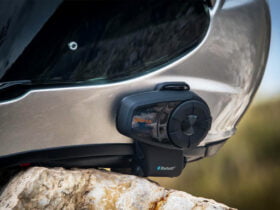Motorcycles have long been a significant portion of the entire automotive business, even if they are not as popular as cars and are geared toward people who enjoy the feeling of speed, independence, and agility. Bikers are significantly less protected than those driving in the comfort of their cars. Thus, all these advantages come at a price.
But, as technology advances, so do our phones, houses, and automobiles. It is only reasonable to assume that the protective gear sector will take the same innovations in motorcycle gear and benefit from current technology to increase rider safety.

Read Also: Best Bluetooth Motorcycle Headsets
Top Innovations in Protective Motorcycle Gear and Safety Features
1. Smart Helmets
Helmets significantly impact the safety of a motorcycle rider. But they are bulky and strong by nature, producing many blind spots. Motorcycle helmets have seen some weight loss and fascinating modifications, such as blind spot cameras and GPS systems, during the past few years.
Some of these devices even can interact with the most advanced urban transportation technology and give the passenger HUDs vital vehicle information. All of these modifications make riding more comfortable and significantly safer.
2. Anti-Lock Braking System (ABS)
If you’re unfamiliar, ABS stands for an anti-lock braking system, which quickly releases and reapplies the brake force to prevent the wheels from locking. This kind of brake system-equipped vehicle is also a highly well-liked business investment for a good reason.
Returning to motorbikes, the Insurance Institute for Highway Safety reports that this technology reduces fatal collisions by 31%. Hence, we are pleased to inform you that smart throttle control and ABS are slowly becoming industry norms instead of exceptions.
3. Airbag technology being used for clothing
Modern motorcycle gear items like jackets, vests, and bodysuits have smart airbags that deploy in the event of a collision without suffocating, overburdening, or hurting the rider. However, such a straightforward description may sound cumbersome and impractical.
While a high innovation in motorcycle gear, airbag apparel has been employed in professional motorcycle racing for many years. Yet, it is only now that airbag suits are sufficiently streamlined and cost-effective to penetrate the consumer market widely.
4. Automated clutches and stability control
Changing gears while driving at high speeds or in congested areas can be extremely confusing for novice drivers, just like with four-wheeled vehicles. Regarding maintaining stability, the same can be true. The Highway Loss Data Institute reports that a novice rider is four times more likely to have an accident in the first month than during the entire second year of riding.
Acquiring these motor abilities takes time, which new riders frequently lack. Automatic clutches and stability control significantly reduce these terrible figures.
5. Vehicle-to-vehicle communication
Another technological advance that was directly appropriated from the auto sector. Some contemporary motorcycles may, in fact, “inform” nearby vehicles of their existence so that their drivers can respond appropriately, much like their four-wheeled counterparts can.
Although the introduction of this technology is still some time off, when it is utilized more widely, collisions brought on by drivers passing by at dead angles may ultimately become a thing of the past.
6. Tire pressure and performance monitors
Motorcycles are intricate devices with numerous intricate mechanisms, all of which must operate flawlessly to guarantee safe riding. Unfortunately, until it is too late, we usually have very little understanding of what is happening below when we are in the seat.
This issue is resolved by contemporary motorcycle monitoring systems, which give the rider crucial information on essential vehicle systems. As the tires give the vehicle the necessary grip and keep the rider firmly on the ground, we mentioned tire pressure monitors.
Conclusion
We hope these examples helped you better understand how the motorcycle industry is changing. Faster, leaner, and more affordable for the typical consumer are all characteristics of the vehicles we are developing. As a result, the innovations in motorcycle gear for the general consumer must keep up with performance improvements. Thankfully, every sign we’ve seen up till now has been positive.
FAQs
Innovations in motorcycle gear to improve safety include improved impact protection through advanced materials like carbon fiber and advanced foam padding, as well as reflective materials to increase visibility.
Advancements in technology have greatly impacted the comfort of motorcycle gear, with many manufacturers now using advanced materials and construction techniques to create lightweight, breathable, and moisture-wicking gear.













Leave a Reply